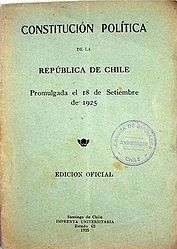Chilean Constitution of 1925

Cover page of a 1925 Constitution text edition.
The Constitution of 1925 was the constitution in force in Chile between 1925 and 1973 when the Government Junta suspended it. In the 1920s Chile had a severe social and economic crisis that led to the loss of prestige for old ruling class, labeled oligarchy in Chilean historiography, and the rise of a more sensibilized populist government led by Arturo Alessandri. In 1924 Alessandri was outed in a coup, but was called back in 1925 to complete his mandate. Alessandri then used his presidency to draft a new constitution to replace the Constitution of 1833. The constitution was approved by plebiscite by 134,421 voters on August 30 of 1925.[1] Prominent features of the constitution were:
- Separation of the church from the state. This was the fulfillment of an old goal among many liberals in Chile. Previously this issue had caused a series of conflicts and controversies in the 19th century.
- Legislative initiative powers to the president. (Reinforced with subsequent reforms)
- Created an electoral tribunal. This reform increased the democratization of elections that were still manipulated in large parts of the country.
Principal reforms
- 1943: Creation of Comptroller General of Chile (Contraloría General de la República).
- 1963: Autorizes the Agrarian Land Reform (reinforced in 1967).
- 1970: Creation of Constitutional Court.
- 1970: Democratic Guarantee Statute, to ensure better democratic freedoms.
- 1971: Expropriation of Great Mining Copper Industry.
References
This article is issued from Wikipedia - version of the 11/7/2016. The text is available under the Creative Commons Attribution/Share Alike but additional terms may apply for the media files.